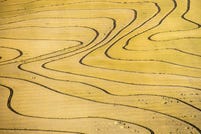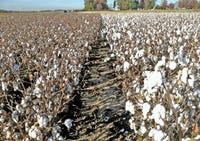
Drought in the West, unsustainable depletion of aquifers in the Mid-South and Southeast, conflicts over access to water across the Cotton Belt, and rainfall that never seems to fall when it’s needed have prompted researchers to step up their efforts to maximize water use efficiency (WUE) in cotton.
WUE, the ratio of yield produced per unit of water used, can be improved through a number of practices in cotton, but irrigation scheduling is one of the easier and more important practices, according to Tyson Raper, Extension cotton specialist at the University of Tennessee.

Perspectives of the Mississippi Delta — photos by Rory Doyle
Some modern, high-water-use-efficiency cotton varieties are capable of producing as much as 150 pounds of seed cotton per acre-inch of water used, he says.
In a limited study in Georgia, 4 inches to 6 inches of supplemental irrigation above seasonal rainfall increased lint yield 250 pounds to 620 pounds of lint per acre-inch.
“We don’t always see that type of yield response, but it is possible with the right timing,” he says.
Crop water demand
Proper irrigation scheduling requires an understanding of available moisture, atmospheric demand and stage of crop development. These parameters are critical to understand crop water demand, Raper says.
“Early in the year, water use in cotton is low. As we move from first square to first flower, water use increases drastically. Water use peaks near peak flower, and as the plant moves through boll fill water use declines.”
Rainfall can satisfy a significant portion of the plant’s water needs — except that it rarely falls at optimum times. Records collected in Tennessee over a 30-year period indicate that during the peak demand period for water, rainfall is in a downward trend.
“So, there is a major deficit,” he says. “We can either fill that deficit with a rainfall event, an irrigation event, or residual soil moisture. Typically, we are left shy of crop water demands, so we see a yield penalty associated with dryland production.
Cotton Incorporated strategy
To help growers increase their WUE, Raper and other researchers are working with Cotton Incorporated under a new water strategy for humid growing regions.
The strategy consists of four components: Maximizing rainfall capture; optimizing irrigation water; increasing plant water use efficiency; and evaluating these practices with credible metrics.
Raper’s work has focused on just two of the components — optimizing irrigation water through improved irrigation scheduling and increased plant water use efficiency through selection/placement of more drought-tolerant varieties.

A RESEARCH FIELD in Arkansas clearly shows the benefits of furrow irrigation in the rows to the right compared to non-irrigated rows to the left. (Click to enlarge)
In the Mid-South, “We commonly schedule our irrigations using checkbook or time interval methods,” he says. “These methods tend to rely on rough estimates of atmospheric demand and crop water use.
“We feel that the use of in-season measurements can drastically increase water use efficiency of the system.”
On the leading edge of irrigation scheduling technology is an irrigation app developed by Dr. George Vellidis’ research group in Georgia. It is based on a network of weather stations called the Georgia Automated Environmental Monitoring Network (GAEMN).
The app does not recommend irrigation amounts, but does advise the user of root zone water deficiency in terms of inches and percent total, and provides weekly estimated ET. It uses information from GAEMN to extrapolate atmospheric demand, an important component of evapotranspiration.
For states which don’t have elaborate networks of weather stations, there are other methods. One low-tech method is an atmometer, which is capable of providing a reference ET, Raper says.
“It allows water to evaporate out of a ceramic cup. The rate of evapotranspiration indicates atmospheric demand which can be used to calculate ET.”
In-field sensors
Raper is also studying the pros and cons of in-crop canopy and soil sensors to aid irrigation decisions. Among these are canopy temperature sensors.
“We typically see good relationships between these sensors and drought stress,” he says. “To schedule irrigations using them, we would establish a threshold buffer between canopy temperature and air temperature, accumulate stress units when the buffer is violated, and trigger an irrigation event when stress reaches a certain threshold.”
Cloudy conditions present a significant issue for canopy sensors, however.
“When clouds come over the crop, we see canopy temperature and air temperature meet, making the measurement almost useless. It’s not that canopy temperature doesn’t have a fit in the Mid-South and Southeast. But as scientists we’re not really sure what to do with clouds just yet.”
Canopy sensors are very easy to install, but can interfere with row traffic.
Soil moisture sensors have a great deal of potential for scheduling, according to Raper, but they can also be difficult to install. They can also interfere with row traffic, but frequently not as much as canopy temperature sensors.
Strong relationships
“We typically find strong relationships between soil moisture sensor readings and actual soil moisture,” he says. “In turn, these readings relate very well to plant water status and can give insight into water availability even under cloudy conditions.”
Raper is studying a variety of soil moisture sensors, including the Decagon 10HS, 5TE, EC-5 and Vegetronix VH400, all of which estimate volumetric water content, and the Watermark 200SS, which estimates soil matric potential.
His initial research indicates that several volumetric water content sensors are very precise, but not necessarily accurate and may need calibration from location to location.
“But if you understand how a given reading relates to plant water status, my data suggest when you reach that reading again, it will have the same meaning. The stability of that relationship through the growing season is critical if using these sensors for scheduling.”
Water potential sensors, such as the Watermark sensor, are also a good indicator of soil moisture, but may not perform as well under dry conditions.
“We still need boots on the ground to calibrate all of these instruments,” Raper says. “They should help us understand when to start irrigating, how long we can wait between events and when to terminate. Ultimately, this should increase our water use efficiency and reduce the economic risks associated with production.”
Drought-tolerant varieties
Producers can mitigate some effects of drought by planting drought tolerant varieties, according to Raper. But there’s work to be done in that area as well.
As new cotton varieties are introduced, “We need a robust understanding of variety drought tolerance in a very rapid time frame. This is not possible without an accurate measurement of in-field drought status conducted in our variety trials.”
Raper and other researchers are working on a drought index for cotton varieties using data collected in 2012 and 2013. While 2013 was not a good year to study drought, “We should have some more useful data from 2014.”
The study is a beltwide collaboration, with sites scattered across the belt on producer fields. One reason so many researchers are currently working on this topic is that the use of drought-tolerant varieties has the potential to enhance water use efficiency of both dryland and irrigated acres, he says.
About the Author(s)
You May Also Like






